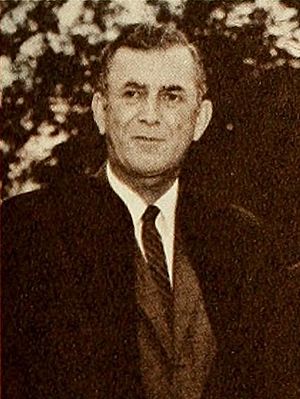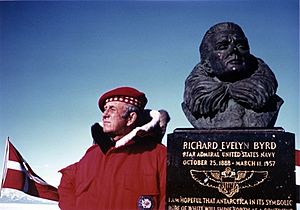Laurence McKinley Gould facts for kids
Quick facts for kids
Laurence McKinley Gould
|
|
|---|---|

Gould in 1961
|
|
| 4th President of Carleton College | |
| In office 1945–1962 |
|
| Preceded by | Donald Cowling |
| Succeeded by | John Nason |
| Personal details | |
| Born | August 22, 1896 Lacota, Michigan, U.S. |
| Died | June 21, 1995 (aged 98) |
| Nationality | American |
| Alma mater | University of Michigan |
Laurence McKinley Gould (born August 22, 1896 – died June 21, 1995) was an amazing American geologist, teacher, and polar explorer. He traveled to both the Arctic (the North Pole region) and Antarctica (the South Pole region). He was the main scientist on Richard Evelyn Byrd's first trip to Antarctica. Gould wrote about this adventure in his 1931 book Cold: the Record of an Antarctic Sledge Journey. He also led Carleton College as its president from 1945 to 1962. Later, he was president of the American Association for the Advancement of Science in 1964. Many things are named after him, like the research ship Laurence M. Gould and places in Antarctica such as Gould Bay, Gould Coast, and Mount Gould.
Contents
Early Life and Education
Laurence Gould was born in Lacota, Michigan, on August 22, 1896. After finishing high school in 1914, he moved to Boca Raton, Florida. There, he taught students from first to eighth grade in a one-room schoolhouse for two years. He saved money during this time to go to college.
In 1916, he started studying at the University of Michigan. However, his studies were put on hold when the U.S. joined World War I. He served in the U.S. Army until 1919. After the war, he returned to the university to finish his education.
Gould earned his first degree in geology in 1921. He then became a geology instructor at the University of Michigan while continuing his own studies. He received his master's degree in 1923 and his doctorate (D.Sc.) in 1925. By 1930, he was an associate professor.
Adventures in the Arctic
In the summer of 1926, Gould went on his first trip to the Arctic. He was an assistant director and geologist on the University of Michigan's Greenland Expedition. This was his first experience exploring cold, icy places.
The next summer, he joined another expedition. This time, he was a geographer and mapmaker for George P. Putnam's trip. Their goal was to map the coast of Baffin Island in Arctic Canada. These trips helped him prepare for even bigger adventures.
Exploring Antarctica with Byrd
From 1928 to 1930, Gould joined Admiral Richard E. Byrd on his first expedition to Antarctica. Gould was a very important part of this team. He was the chief scientist and the second-in-command.
On November 4, 1929, Gould and five friends started a very difficult journey. They traveled 1500 miles by dog-sledge into the Queen Maud Mountains. This trip lasted two and a half months! Their main goal was to help Byrd's historic first airplane flight over the South Pole. They also wanted to study the geology and glaciers of the area. Gould called it "a true paradise for a geologist."
After Byrd's flight over the Pole, Gould and his team climbed Mount Fridtjof Nansen. They wanted to study its geology. Gould found layered sandstones at the top of the mountain. These findings helped prove that Antarctica was once connected to Earth's other continents. This was a very important discovery!
News about the expedition was shared regularly. When Gould returned, he received several awards. These included the gold Byrd Antarctic Expedition Medal and the 1930 David Livingstone Gold Medal.
Life After Expeditions
On August 2, 1930, just two weeks after returning from Antarctica, Gould married Margaret ("Peg") Rice. She had been a student in one of his classes at the University of Michigan.
In the years after his Antarctic trip, Gould traveled all over the U.S. He gave many lectures about his experiences. His 1931 book, Cold: the Record of an Antarctic Sledge Journey, described his tough dog-sledge trek. He wrote about blinding blizzards, snow bridges that broke over deep cracks in the ice, and weather so cold it almost froze a person's eyelids shut. He also wrote scientific papers about what the Byrd expedition discovered.
In 1932, Gould became a full professor and head of the geology department at Carleton College. So, the Goulds moved to Minnesota. He became the president of Carleton College in 1945 and stayed in that role until 1962. In 1963, he retired and moved to Tucson, Arizona. There, he taught about glaciers (glaciology) at the University of Arizona.
He also served as the President of the American Association for the Advancement of Science. This is a very important group for scientists.
Legacy and Honors
During his life, Laurence Gould received 26 honorary degrees. These are special awards from universities.
In 1995, Carleton College renamed its library the Laurence McKinley Gould Library to honor him. The R/V Laurence M. Gould is also named after him. This is a 76-meter-long research ship built in 1997. It is designed for year-round operations in polar regions. Many places in Antarctica are also named in his honor, including Mount Gould, Gould Bay, and Gould Coast.
Images for kids



